Blog
The Last Supernova
17 August 2020
 NASA, ESA, and G. Bacon (STScI)
NASA, ESA, and G. Bacon (STScI)A supernova is a powerful event. For a brief moment in time, a star shines as bright as a galaxy, ripping itself apart in a last, desperate attempt to fight against its gravity. While we see supernovae as rare and wondrous things, they are quite common. Based on observations of isotopes in our galaxy, we know that about twenty supernovae occur in the Milky Way every thousand years. These brilliant cosmic flashes fill the universe with heavy elements, and their remnant dust makes up almost everything we see around us. But supernovae won’t keep happening forever. At some point in the far future, the universe will see the last supernova.
When the last supernova occurs is the subject of a new paper.1 Using what we know about astrophysics, it calculates when the last “interesting” astrophysical event will occur. Supernovae, as we see them today, are caused by massive stars. Since not all of a star’s material is cast out by a supernova, the number of potential giant stars decreases with each generation. Within the next 100 billion years, large stars will stop forming, and the first supernova era will end.
But smaller stars such as red dwarfs will still be burning. They can continue to shine for trillions of years, but even they will exhaust their fuel by about 1014 years. By that time, there will only be the remnant cores of dead stars, collapsed into white dwarfs, neutron stars, or black holes, depending on their mass. Remnants larger than about two solar masses will collapse into black holes. Those with masses between 1.4 and 2.2 solar masses will become neutron stars, and the rest will become white dwarfs.
Black holes and neutron stars are effectively stable. Black holes are matter collapsed to their limit, and neutron stars are held against gravity by the strong force interaction between nucleons. But white dwarfs are a different story.
 Mohamed Ibrahim Nouh
Mohamed Ibrahim NouhA white dwarf star is held against gravity by the degeneracy pressure of electrons. Subrahmanyan Chandrasekhar calculated their upper mass limit to be 1.4 solar masses in the 1930s, and figured that any remnant smaller than that would gradually cool to become a black dwarf. But we now know that things aren’t quite that simple. Heavier elements within the white dwarf will sink, creating a core of oxygen, neon, and magnesium. As the white dwarf cools into a black dwarf, the atoms in the core will move closer together.
Eventually, they will be close enough that an odd kind of fusion can occur. Normal fusion occurs at very high temperatures. Nuclei slam so close to each other that can quantum tunnel to fuse into heavier elements. There’s no minimum distance for quantum tunneling to occur; it is just extremely rare at larger distances. But within the heart of a black dwarf, it will happen. Given enough time, elements in the core will fuse into iron.
It is estimated that this transformation will take about 101100 years. As the core of a black dwarf becomes dense iron, it can reach a critical point. For black dwarfs between 1.2 and 1.4 solar masses, the iron core will become so dense that electron degeneracy can’t prevent gravitational collapse. The core will implode and recoil, creating a supernova explosion. The largest black dwarfs will explode first, followed by increasingly lighter black dwarfs. Eventually, some black dwarf a bit more massive than our Sun will become the last supernova in history, sometime around 1032000 years in the future.
It will be the last burst of light in a cold, dark, and dead cosmos.
Caplan, M. E. “Black Dwarf Supernova in the Far Future.” Monthly Notices of the Royal Astronomical Society (2020). ↩︎